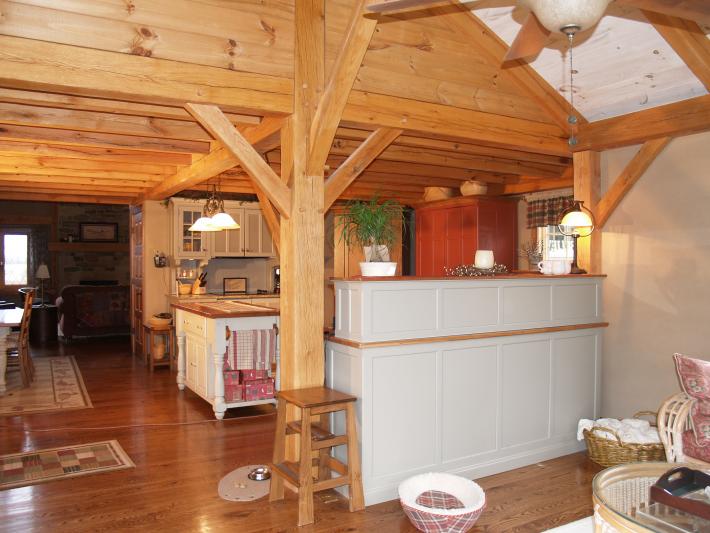 DARLA SALAY Special Sections Writer for the Bucks County Courior Times
DARLA SALAY Special Sections Writer for the Bucks County Courior Times
THE HEART OF THE HOME
We hear all the time: the kitchen is the heart of the home: it’s where families congregate and trumpet the news of the day and where kids dump the contents of their book bags on the table top. It’s where friends sip good coffee in the quiet of the morning and where a cat or dog sprawls lazily across the cool floor.
Without our even knowing it, the kitchen nurtures us. So it should be the place we feel most relaxed, the most at home, in our home.
But according to David Beer, architect/furniture designer now based in Catasauqua, Pa., many kitchens are designed to look sterile, in a static L-shape design, impeding our opportunity to personalize the room we occupy most.
As an architect with 20 years in the business, he saw a need for more comfortable kitchens that reflect the character of other rooms in the home. Particularly the family room, since that’s the room the kitchen most often adjoins. To meet the void he saw, Beer created the YesterTec Design Company, which manufactures kitchen workstations. These are units designed to safely hold, and hide working appliances: sinks, refrigerators, microwaves, ovens, cooktops and dishwashers – and serve as classical furniture with timeless appeal. The workstations leave space in the kitchen for other elements that can bring character to the room. Elements like art collections, desks, fireplaces, extra windows, columns, or even a dog’s bed.
“The kitchen is where people live but it (tends to) look like a laboratory.” said Beer. “This concept allows you to personalize the kitchen, to mix styles and extend design themes.”
He said the spaces between the units make it possible. “The spaces between the units are what allows people to bring the design of other rooms into the kitchen,” he said. With the workstation concept, “You eliminate things like soffits and wing walls for built-in cabinets. These units are freestanding and very three dimensional. It turns the kitchen into a living space.”
And Beer said the units themselves become part of the design. “They actually become a focal point and some of them were designed as focal points,” continued Beer. “We have different kinds of cornices that make them look more architectural. One has a pediment cornice that looks like a little roof. Another piece has columns that make it look like an architectural gateway.”
SAFETY APPROVED
All the workstation enclosures that conceal appliances with heating functions are approved by Underwriter’s Laboratory. According to Beer, this technology makes his company the only one with such approval for kitchen workstation enclosures. “That (approval) process took about three years,” he said. “After months of experimentation, I realized that the way to really make this concept work was to hide the appliances completely,” said Beer. He sought UL approval so the appliances would pass all safety codes in the U.S. and Canada. “Other companies may have done something similar to this an got local inspectors to sign off on it, but we are looking beyond that.”
The concept for safely concealing appliances seems simple: when a heating appliance is not being used, electricity does not power it. “We have an automatic lock that senses when the oven is on and even when cooling fans are on. Nobody can turn on an oven and have the doors close in front of it,” said Beer. “When you are using an appliance, you open the doors and slide them back into a pocket…where they flip a switch which turns the power on to run appliances ,” he said.
HEIRLOOM QUALITY
The workstation concept seems to blend the best of the past – furniture built to withstand time – with the best of today, modern technology. Each piece of furniture is designed and styled based on classical designs, bringing a characteristic 18th century style to the kitchen. Beer wanted the pieces to blend with furniture people already had so existing furniture would coordinate.
The workstations are built from solid pine, cherry, maple and mahogony, and natural finishes such as marble, granite and slate, “These are heirloom pieces, they are built to last forever,” said Beer. “The concepts came from the past, but they are not reproductions.”
Louvered doors gives one of t his designs a tropical look reminiscent of the south, while another has a grid design, similar to furniture styles of old Japan. Another of the designs evokes a nautical feel, with a door that looks like “an old hatch cover.”
The shape of the pieces hints a more relaxed feel in the kitchen. “Every corner of the piece is a place to lean against. At parties people tend to wind up in the kitchen. With these pieces you have many corners to lean on and you can enjoy the feel of the furniture,” he said.
Because the pieces are independent, styles can be mingled. “You don’t have to worry about matching everything. For example, you can use granite where you really need it, around the cooktop or oven, and the sink could have a different countertop.”
YesterTec markets to individual homeowners and others in the trade such as kitchen designers, architects, interior designers and builders. Customers can view the units in YesterTec’s showroom in Catasauqua, PA.
Prices vary considerably, depending on sizes and options, but a client might expect to spend $20,000 and up on a three piece kitchen. He said this would include “nicely equipped pieces” to hold a sink with a dishwasher; range with a cooktop, microwave/hood and oven; and a refrigerator with a storage pantry on the side. You can also opt to purchase individual pieces. “You don’t have to buy a whole kitchen. You may just want to enclose your refrigerator or if you have a country look, you may want to put in a double oven unit that looks like a pie safe.”
Most manufacturers appliances fit the workstations. “We can use many manufacturers appliances,” he said. “That was a big consideration for us.”
Beer said the units would work in any home, particularly older homes and farmhouses, where the owners are trying to exude a classical style. But he said people who live in lofts in places like SoHo have also expressed interest. And because the units are moveable they would work in such dwellings. “These units can be moved just like furniture,” he said.
It seems they were designed for the long haul.








